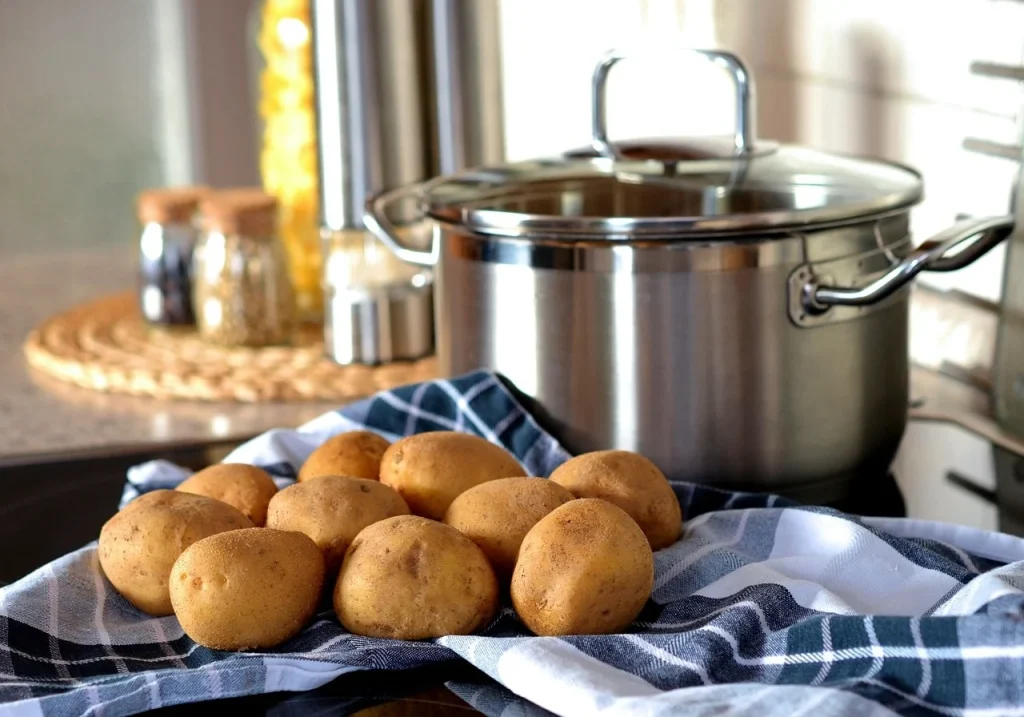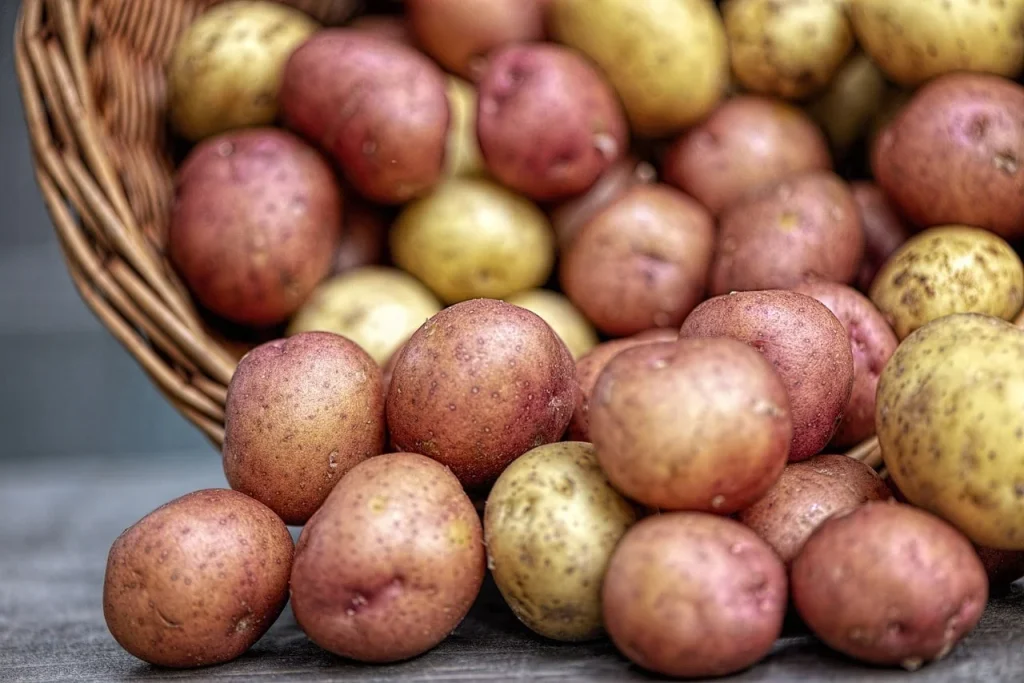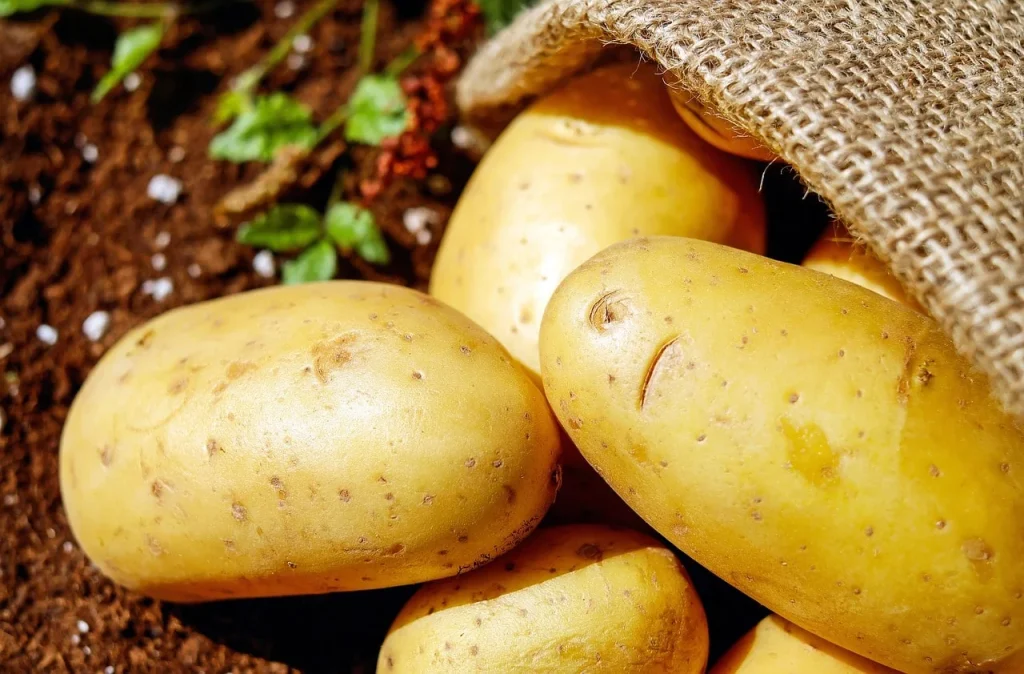Let’s talk about potatoes, the root vegetable that has carved its legacy not only on our plates but also in history. From fueling gold rush miners to being the first vegetable grown in space, potatoes have done it all.
They’ve even managed to sneak into folk remedies and beauty treatments. With such a versatile resume, it’s no wonder they’re a staple in nearly every cuisine. But how much do you really know about these amazing tubers? Let’s start our journey.
What I say is that, if a man really likes potatoes, he must be a pretty decent sort of fellow.
A.A. Milne
Potato Facts
Get ready to dig deep into the world of potatoes! We’ve compiled interesting facts that every spud lover should know. Read on and absorb every detail; a quiz awaits at the end to test your potato prowess.
- Potato plants are actually perennials, usually grown as annuals.
- One of the earliest domestication sites for potatoes dates back to 8000 BC in Peru.
- These plants produce flowers and berries that resemble green cherry tomatoes, both of which contain the toxic alkaloid solanine.
- Space agriculture has seen them grow successfully aboard the Space Shuttle in 1995.
- The largest one ever recorded weighed about 10 pounds, equivalent to that of a small dog.
- The “Guinness World Records” list the most varieties planted in one place at 343 different types.
- They can be used to polish silver, thanks to the oxalic acid content in the skin.
- Electricity can be generated using slices of potatoes.
- During the Klondike gold rush, miners traded gold for these tubers because of their vitamin C content.
- The word “spud” originally referred to the tool used to dig up plants, not the plant itself.
- Historically, they were thought to cause leprosy and were banned in Burgundy, France, in 1748.
- They share 60% of their DNA with tomatoes.
- Maria Antoinette wore these plant blossoms in her hair at a ball to promote their cultivation.

- The U.S. government promoted these tubers during World War I to encourage people to eat more of them and conserve wheat for the troops.
- Thomas Jefferson introduced French fries to America after enjoying them in Paris.
- The first European contact with these tubers was in 1532, when Spaniards conquered Peru.
- The International Potato Center in Peru houses the world’s largest collection of tuber varieties in a gene bank.
- China is the largest producer, responsible for about a quarter of the global supply.
- A technique called “potato grafting” is used to grow these plants that are resistant to viruses.
- The average American consumes about 110 pounds annually.
- The starch extracted from potatoes can be used to make biodegradable plastics.
- The largest crop ever harvested was in Germany in 2014, weighing over 10 million tons.
- In 2018, a study discovered that these plants could grow in Martian soil under controlled conditions.
- Late blight is a disease that affects these plants and was responsible for the Irish Potato Famine.
- These tubers are made up of about 80% water.
- The skin contains more nutrients than the rest of the tuber.
- Toxic compounds can form in these plants when exposed to too much light, turning them green.
- Blue and purple varieties are high in antioxidants and can help reduce blood pressure and boost the immune system.

- “Chuño” is a freeze-dried potato product that ancient South Americans made as a preservation method.
- More than 1,000 different varieties are native to the Andes alone.
- New World crops like these significantly changed the agricultural landscape of the Old World after the Columbian Exchange.
- They are the fourth most important food crop in the world after rice, wheat, and maize.
- Gluten-free, making them an ideal food for those with celiac disease.
- Alcohol, such as vodka, can be produced from them.
- They are more energy-efficient to grow than cereals, yielding more food per acre with less environmental impact.
- Potato flowers are sometimes sold as ornamentals for their aesthetic value, despite their toxicity.
- The Potato Museum in Belgium is dedicated to the history, cultivation, and uses of these tubers.
- “Petite Marbles” are tiny, marble-sized potatoes that are fully mature and highly gourmet.

- In 2005, Peru declared the “Year of the Potato“ to celebrate its genetic diversity.
- Their skin has more iron than the same amount of spinach.
- These tubers are used in folk medicine in various cultures to treat ailments ranging from skin irritations to rheumatism.
- The inedible parts of these plants are sometimes processed into feed for livestock.
- Gnocchi, a type of Italian dumpling originally made primarily from these tubers, dates back to Roman times.
- They can absorb and store excess carbon dioxide from a small space, making them ideal for small, controlled environments like space stations.
- Alton Brown, a famous chef, recommends storing them with an apple to avoid sprouting.
- The process of “potato printing,” using a cut section to make patterns, is popular in elementary arts and crafts.
- The sweetness increases when stored at colder temperatures due to starch converting into sugar.
- The Potomack Company sold a 17th-century painting of these plants for $115,000, noting its historical significance.
- Some species of potatoes can be naturally purple or even blue inside, offering a vibrant alternative to the usual white or yellow varieties.
- At high altitudes, these tubers can take up to twice as long to cook due to the decreased air pressure, a fact often overlooked in culinary practices.
Potato Myths

Now that we’ve covered the facts, let’s clear the air. In the next section, we’ll distinguish the myths from the truth about potatoes.
- Potatoes Make You Fat
They are often blamed for weight gain, but in themselves, they are not fattening. It is generally the high-calorie toppings and cooking methods, like deep-frying, that contribute to weight issues. Potatoes are actually low in calories and rich in essential nutrients. - Potatoes Offer No Nutritional Value
Contrary to popular belief, they are rich in vitamins, minerals, and fiber. They are especially high in vitamin C and potassium. The nutritional content can be maximized if potatoes are consumed with their skins on. - Sweet Potatoes Are Much Healthier Than White Potatoes
Both sweet and white potatoes offer different nutritional benefits. While sweet potatoes have more fiber and vitamin A, white potatoes provide more iron and magnesium. Each has a valuable place in a balanced diet. - Potatoes Are High in Sugar
They are not high in sugar; they contain complex carbohydrates, which are broken down into sugars naturally in the body to provide sustained energy. The glycemic index can be lowered by eating potatoes with proteins and healthy fats. - Green Potatoes Are Safe to Eat
Green potatoes indicate the presence of solanine, a natural toxin that is produced when potatoes are exposed to too much light. It is advised that these potatoes be avoided or the green parts thoroughly removed before consumption to prevent the risk of toxicity.
No products found.
Potato Quotes

Prepare to be surprised by the wit, wisdom, and sheer hunger reflected in these quotes about the mighty potato. Feel free to share yours in the comments so I can add them to the list as well.
Potatoes are one of the last things to disappoint me.
Michael Pollan
Michael Pollan expresses his trust in potatoes as a reliably satisfying food, underscoring their steadfast presence in culinary traditions.
A potato can make nearly any meal better.
Oprah Winfrey
Oprah Winfrey praises the potato’s versatility and its ability to enhance almost any dish, celebrating its culinary value.
Potatoes are the only food that’s absolutely impossible to get tired of.
Björk
Björk asserts the enduring appeal of potatoes, suggesting their unique quality of being perpetually enjoyable.
There’s nothing half so pleasant as coming home again, and that’s what I think whenever I think about potatoes.
Margaret Atwood
Margaret Atwood uses potatoes metaphorically to evoke feelings of comfort and the warmth of returning home, reflecting their homely, comforting nature.
The potato is your canvas, and you are the artist.
Gordon Ramsay
Gordon Ramsay celebrates the creative potential of potatoes in cooking, emphasizing how they offer a versatile base for culinary creativity.
Potato FAQ

As we round out our exploration of potato wisdom, you’re approaching the final section before the quiz. Dive into the FAQs to bolster your knowledge and ace the upcoming trivia.
- Can potatoes be frozen?
Absolutely! You can freeze them, but it’s best to blanch or cook them first to maintain their texture and flavor. Raw potatoes may become watery and grainy when thawed. - Are potatoes good for dogs?
Yes, in moderation. Cooked potatoes can be a healthy treat for dogs, as long as they’re plain (no butter, salt, or seasoning) and given in small quantities. However, raw potatoes are a no-go, especially the green parts, as they can be toxic. - Can potato plants survive frost?
Potato plants are somewhat frost-sensitive. While they can handle light frosts, a hard frost can damage the plants. It’s a good idea to cover them or use mulch to protect against unexpected cold snaps. - Will potatoes raise blood sugar?
Yes, they contain carbohydrates that can raise blood sugar levels. People with diabetes or anyone monitoring their blood sugar should consider the portion size and the overall impact on their meal plan. - Can potatoes go bad?
Indeed, they can. They go bad over time, especially if stored in a warm or moist environment. Look out for signs like soft spots, sprouts, a musty smell, or a green tint, all of which suggest it’s time to toss them.
No products found.
Potato Trivia

Welcome to the ultimate potato quiz! If you can’t dig up the right answers, you might just find yourself getting mashed by the Potato Overlord.
Potato Merch
If you are a true fan of potatoes, then you definitely need to check out our merchandise. You can find T-shirts, hoodies, mugs, and tote bags for your favorite designs. Feel free to check out all the other designs in our shop.
Conclusion
So there you have it—potatoes are not just food; they’re a cultural phenomenon. Easy to grow and even easier to eat, they’ve been a staple for centuries.
As we’ve learned, whether it’s in science, history, or nutrition, potatoes have a lot to offer. Let’s keep celebrating the spud in all its forms. Till next time, stay curious and explore more. Cheers.


